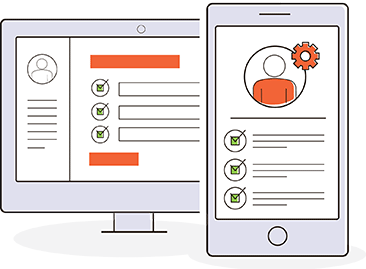Process Redesign
A redesigned process yields a more efficient, less wasteful, and higher-quality output

Redesigning an outdated process or operating procedure creates an Automated Business Process (ABP). This ABP can increase productivity, quality, employee experience, customer satisfaction, and Return On Investment (ROI).
Growing a business in the modern competitive environment requires enterprises to advance past old systems and methods. Innovative company leaders think beyond continuously tweaking existing OPs to transformative process redesign, as needed, to keep pace with their industry. That often involves reimagining core operational functions, which can entail “breaking things," i.e., dismissing old ideas of production, marketing, sales, service, and management. Today’s leaders are pressed to do what it takes to scale productivity in this new operational paradigm.
What Is a Process Redesign?
A business process redesign (BPR) is an effort to change an existing process to one that is more efficient. It involves converting a current set of actions performed to produce an output to a different, more advantageous method. Generally speaking, a redesigned process ideally yields a more efficient, less wasteful, and higher quality result than the replaced process.
A Business Process Reengineering (BPR) typically involves a significant reconfiguration.
This includes the process workflow management tools, internal regulative protocols, and communications modalities.
The result is a digitally driven and facilitated system. A Business Process Re-engineering (BPR) aims to transform a process. This transformation increases the production speed, quality, and Return on Investment (ROI).
What are the Benefits of Redesigning a Business Process?
The benefits of transitioning to an automated business process can be pretty dramatic. Typically, the performance of the prior process is not comparable to the results of the redesigned process in any performance metric. Here are some significant benefits of converting to a digitally driven or assisted process. Upgrading to an ABP can substantially:
- Turnaround time reductio
- Increase productivity
- Improve consistency
- Improve quality
- Reduce labor costs
- Improve communications
- Improve customer satisfaction
- Reduce waste of time and energy
- Improve competitiveness
- Improve departmental agility
- Simplify operations
- Contribute to streamlining the larger system
Why Should a Business Process Be Redesigned?
The need to redesign a process may become apparent in a range of ways. For example, performance metrics may reveal:
- Slow production
- High employee attrition
- High stress
- Poor team cohesiveness
- Frequent points of indecision
- Dysfunction without key employees
- Shrinking profit margins
- Poor communications
- Low overall sales productivity
- Poor repeat sales rates
- Poor customer service
- Losing market share
- Departmentally siloed data
- Noncompliant processes
- Excessive inventory
- Excessive backorders
- Cash flow problems
- Brand damage
What are Some Examples of Redesigned Processes?
How do companies use automated processes? To understand how digital automation can help, review some workflow automation use cases. These offer insights into the vast possibilities for businesses using workflow management software to increase efficiency and accountability across their organizations. For example, digital workflow use cases include updating capabilities or expanding the scope of:
- Accounting
- Receivables/Payables
- Payroll
- Production
- Shipping and Delivery
- Human Resources
- Product Management
- Information Technology
- Administration
- Risk Management
- Marketing
- Sales
- Customer Service
- Purchasing
- Internal network
- Maintenance
- Security
- Fleet management
How is a Process Redesign Best Used?
As discussed in the sections above, there are wide-ranging applications for business process redesign. We can think of a conversion process as a continuous improvement (CI) initiative.
This initiative is for a particular product or service. A business process redesign also involves the discipline of Business Process Management (BPM). So, company leaders of BPR projects should have a sound introduction to these critical skill sets.
How Can Integrify Help with Redesigning Processes?
Integrify process redesign experts utilize the latest digital tools and cutting-edge design concepts. This helps them create custom automated workflows among the world's most innovative and concise. We further optimize process communications and seamlessly integrate existing software systems to maximize efficiency and enrich workers’ knowledge access through internal networking.
Some of the essential transformative process redesign services we provide include:
- Comprehensive digital needs analysis
- Building digital replacement processes
- Designing fillable digital forms
- Comprehensive platform integration
- Custom service portals
- Progress metrics and reporting
- Process integration API
- Custom industry-specific workflow solutions
- Custom department-specific workflow solutions
FAQs About Process Redesign
Isn’t modifying the existing process more financially practical than reinventing it?
Experienced leaders in virtually every industry have become well aware of the limited potential of merely incremental process improvements to outdated manual means of production. The most effective competitors in any market are typically those who have recognized and acted on the need for automated processes.
What resources are available for companies considering redesigning processes?
Here are just a few of the many helpful resources Integrify offers to decision-makers charged with evaluating the option to convert a key area of operations to an automated process:
How Does Integrify Increase a Business’s Profit Margins?
Integrify provides innovative operations platform development and redesigns processes to enable digitally driven and facilitated production methods. Our experts implement automated tools that simplify processes. We provide team training and coaching on the new user-friendly technology.
Integrify’s open API, low-code programming approach to process digitization is ideal for custom design of systems that interface with existing software. Our approach eliminates unnecessary complications in processes for more efficient, consistent, reliable, and less frustrating daily operations.
Interested in Redesigning Your Processes?
We have a library of resources to help you on your journey to an automated workplace.

